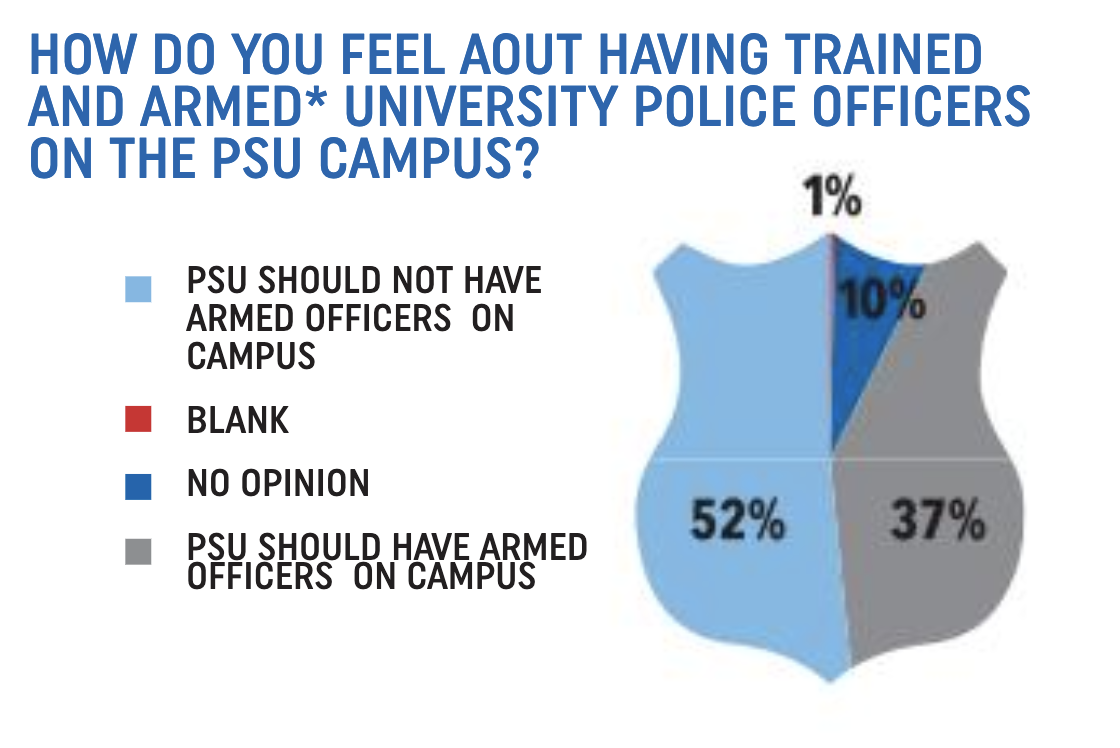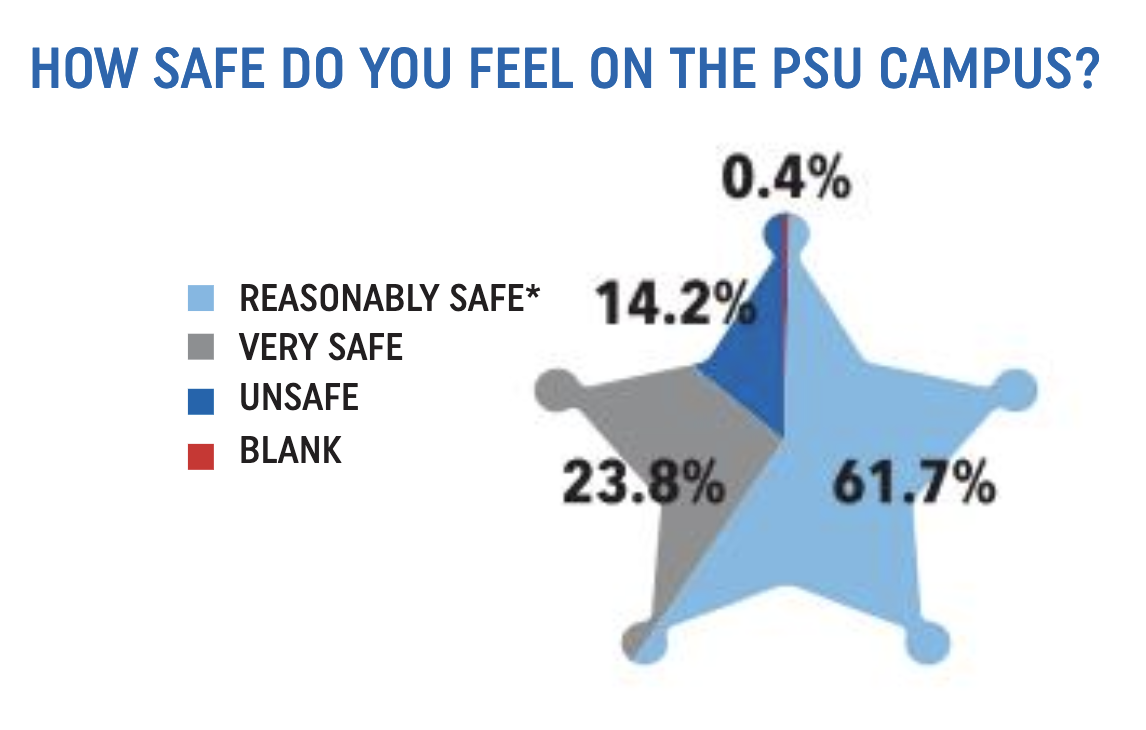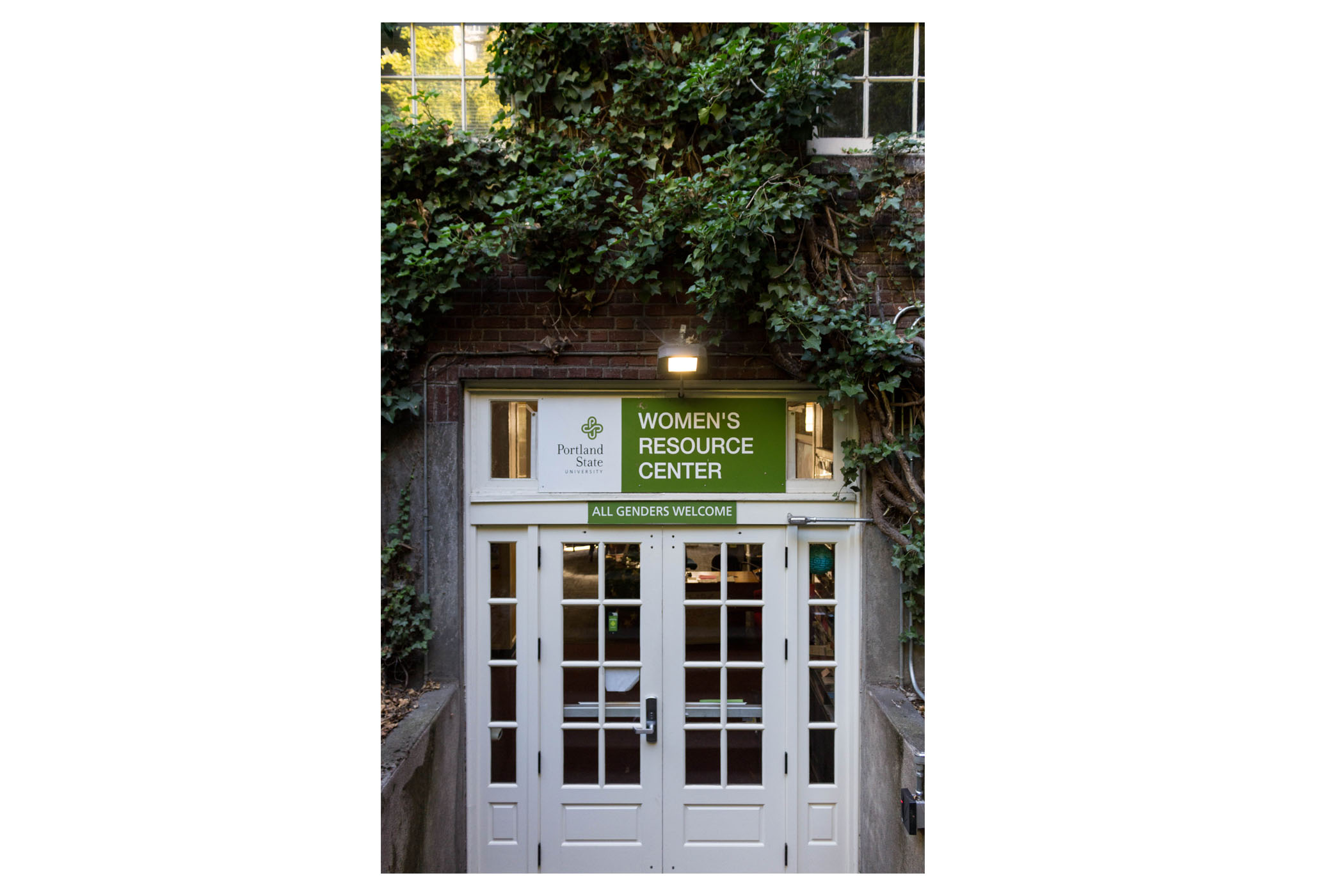Margolis Healy released its Public Safety Management Study and Safety and Security Program Assessment on Feb. 22, which discussed issues regarding disarmament, CPSO staffing changes, houselessness and mental health.
The campus public safety review came in response to the fatal shooting of Black Navy veteran Jason Washington by campus police officers James Dewey and Shawn McKenzie on the morning of June 29, 2018.
In a Sept. 13, 2018 response to the decision by a Multnomah County grand jury decision not to indict CPSO officers for Washington’s death, Portland State President Rahmat Shoureshi described the review as “a road map for updating and modifying campus safety policies and procedures, such as Campus Public Safety Office staffing and resources, officer training, and our relationship with local law enforcement.”
Over three weeks, consultants from Margolis Healy met with different stakeholders on campus, distributed an anonymous online survey with questions about campus safety and convened nine listening forums on Oct. 30, 31 and Nov. 1.
During one of the listening forums the report’s authors identified a recurring theme of “an overall feeling of anger, mistrust and frustration among the campus community with the forum and assessment process,” and that “[the campus community] is concerned that those in authority will not listen to the concerns of the community.”
The report also noted the significant financial investment required to implement many of its recommendations, stating “the university may not be in a position to realize the recommendations related to maintaining a sworn and armed police department,” and “it may be impossible to implement the higher priority recommendations in a timely fashion.”
Disarmament
An external consultant recommended the university retain its armed police force amid a majority of students, faculty and staff supporting disarmament of Portland State police officers.
Margolis Healy’s assessment concluded PSU should not disarm campus public safety officers. A primary reason cited in the report is based on the fact that other universities have an armed police force, so PSU should too, according to the firm. “Having immediate access to its own armed officers is the standard amongst its peers and in the State of Oregon,” the report stated.
It goes on to state having armed officers is the “standard of care” in legal proceedings, implying PSU could be considered liable in court if they do not have armed officers.
Less than a week after the report was released, Oregon Congressman Diego Hernandez and the Oregon Student Association announced a bill to disarm campus police at both PSU and University of Oregon based on outcry from students at both campuses.
“This bill is about making students at our university campuses safer,” Hernandez stated in a press release. “The fact of the matter is students at both campuses have said time and time again they do not want armed police on their campus.”
Kenny Ma, PSU’s director of media relations, said the university should be able to follow its own process without a mandate from the legislature.
“It’s important that the legislatively established public university boards of trustees be authorized to establish the policies they believe are best to ensure the safety of everyone on PSU’s campus,” Ma told OPB.
Administrators have no immediate plans to implement any of the 151 recommendations included in the report, including those involving armed campus police. PSU’s Board of Trustees will meet from 9 a.m. to noon on March 7 in the Smith Memorial Student Union Ballroom to discuss the report with representatives from Margolis Healy. The meeting will be open to the public.
According to the report, 52 percent of students, faculty, staff and community members surveyed by Margolis Healy said PSU should not have armed officers on campus. Follow-up comments to the survey cited institutionalized racism in the justice system and on-going oppression of people of color as reasons for armed officers making campus less safe.
One survey respondent stated, “You can never train someone ‘enough’ to be able to protect marginalized people if they are armed. People of color, trans people and immigrants are put at great physical and emotional risk as long as these officers are armed. They killed an innocent black man on this campus. That should be reason enough.”
The Margolis Healy report investigated the original decision to arm CPSO and found the university’s process to create an armed police force was “deliberate and well informed.” The report claims the university understood and respected the anti-arming perspective and fully considered the opinions of campus members opposed to having an armed police force.
The report further states that due to campus crime and PSU not being able to partner with other police agencies, “the [Special Committee on Campus Public Safety] believed it had only one viable option for ensuring access to sworn and armed officers—establishing its own campus police department.”
The report includes a list of five alternatives for maintaining campus safety.
1. RETAIN SWORN OFFICERS, BUT DO NOT EQUIP THEM WITH LETHAL FORCE WEAPONS
This option has the most support from campus members. The report lists the disadvantages of this option—officer safety, reliance on PPB, difficulty recruiting and retaining officers and potential collective bargaining implications.
2. RETURN TO A DEPARTMENT STAFFED EXCLUSIVELY WITH NON-SWORN CAMPUS SAFETY OFFICERS
This option would be amenable to and supported by the majority of campus members, according to the report. The main disadvantages listed are reliance on PPB for response to violent crime and PSU’s lack of oversight for the actions of the PPB.
3. CONTRACT FOR PRIVATE SECURITY OFFICERS
The report explores the advantages and disadvantages of hiring both armed and unarmed private security but concludes that “PSU would also lose its ability to build and maintain a campus safety department that is reflective and responsive to the specific needs of the PSU community.”
4. CONTRACT FOR POLICE SERVICES WITH THE PORTLAND POLICE BUREAU, THE OREGON STATE POLICE OR THE OREGON HEALTH AND SCIENCE UNIVERSITY (OHSU)
This option is dismissed outright based on the previous studies that led to the creation of the armed force. PPB, OSP and OHSU are not willing to provide officers to support PSU according to the Special Committee on Campus Public Safety meeting held on Oct. 27, 2014.
5. MAINTAIN A CAMPUS POLICE DEPARTMENT WITH BOTH SWORN POLICE OFFICERS AND CAMPUS PUBLIC SAFETY OFFICERS (THE HYBRID MODEL)
This model argues CPSO should maintain a 50/50 balance of sworn officers who are armed and non-sworn, unarmed officers. This was the original intent when PSU decided to arm officers, but the report found that “…it appears that the department has steadily moved
away from hiring non-sworn officers in lieu of sworn members.’

Courtesy of Lisa Dorn
Organizational and staffing changes for CPSO
The Margolis Healy report recommends filling or creating over 30 new or vacant positions, including filling vital absences such as police lieutenant and creating new oversight positions. The report also suggests increasing the power of Portland State’s oversight committee to better deal with the university’s needs.
According to the report, the University Public Safety Oversight Committee should form a subcommittee to articulate how “the [Campus Public Safety Office] carries out its responsibilities” and plans around its mission and core values. This committee should report directly to the university president, who in turn should report to the Board of Trustees.
Luis Balderas-Villagrana, Associated Students of PSU president and a member of UPSOC, said he was in support of expanding the role of the committee, but also expressed concerns about whether the recommendations will lead to meaningful change or oversight.
“Is it just looking at some reports from CPSO?” Balderas Villagrana said. “Is it actually doing anything? Having more people on a committee doesn’t necessarily make it better.”
At PSU, UPSOC can currently review and make recommendations regarding “policies and procedures adopted by CPSO.” Margolis Healy recommends the language be amended so UPSOC can directly initiate policy and procedure recommendations based on CPSO’s tactics and use of force. CPSO would also be required to share substantial changes to policies and procedures at least thirty days before implementation.
The report recommends making UPSOC a fully functioning oversight committee as to determine available resources as well as the needs of PSU and campus community. Margolis Healy recommends PSU consider a student engagement subcommittee with open forums to listen to student concerns and determine how “CPSO is engaging with the campus community.”
PSU should also consider significant enhancements to the UPSOC website to provide more pertinent information to the campus community, according to the report. Margolis Healy recommends updating the UPSOC page with a mission statement, CPSO training types and lists, CPSO involvement calendars and a citizen complaint form specifically to be overseen by UPSOC and not CPSO.
Margolis Healy recommends an external, independent monitor be employed for two to three years to oversee implementation of the recommendations in the report.
The staff recommendations also include an overhaul of middle-level management and first-line supervision within CPSO. The position for police lieutenant has been vacant since June 2018, a role serving as “second-in-command of CPSO,” according to the report.
The vacant Police Lieutenant position should be filled to assume responsibility for “operational aspects of the department, such as patrol, investigations and the field training position.”
Margolis Healy also suggests creating a second lieutenant’s position for training and internal affairs and a third lieutenant’s position for the campus liaison unit.
The report states staffing is deficient of about 20 frontline officers and suggests creating two new sergeant’s positions as frontline supervisors, as well as creating over 22 additional non-sworn positions to fill the need of unsworn officers and staff at CPSO.
Additionally, the firm suggests CPSO designate a manager for physical security, responsible for the “oversight and coordination of all physical security efforts” such as campus protection and key-card entry access. It also recommends PSU form a multi-disciplinary “security work group” with members from CPSO, OIT and Housing and Residence Life, among others, chaired by the manager for physical security.
Houselessness and safety
Compared to nearly a dozen other reports by Margolis Healy on campus safety, Portland State’s report is the only one with mentions of homeless people as “non-affiliates,” revealing the unique issue posed by houseless communities on urban campuses.
The report includes 108 mentions of the words “homeless,” ”homelessness,” “houseless,” “unhoused” and “transient,” and includes several recommendations centered around the way campus community members and police interact with houseless individuals.
The report recommended establishing a unit of officers paired with certified mental health professionals to respond to calls involving houseless individuals or those who are suspected of intoxication. Margolis Healy also recommended for that unit to partner with the School of Social Work, the university’s Homeless Research Action Collaborative and the City of Portland Joint Office of Homeless Services.
The report also recommends CPSO continue collaborating with the Portland Police Bureau on matters connected to houselessness.
Voices from the community were also included in the report, with some mentioning houseless people utilizing the buildings for a variety of reasons, including “shooting heroin” which “undermines the university’s fundamental obligation to provide a reasonably safe environment for its members.” Other respondents expressed concerns about how CPSO interacts with the houseless population.
Margolis Healy found PSU has an inconsistent application of security measures and lacks clear policy, documentation and standardization of management of the school’s physical security program. To mitigate this security risk, the firm recommended an access/visitor strategy to permit non-affiliates the use of the campus when appropriate, refuse access for illegitimate uses.
Attendees of the Margolis Healy forums were deliberate of their expectation that the university uses innovative practices and “invest in addressing the root causes of houselessness in [Portland],” while not depending on the CPSO for incidents involving houseless people.

Courtesy of Lisa Dorn
Mental Health
One recurring issue addressed in the report concerns how campus security could better interact with people who have a mental illness or are experiencing a mental health crisis.
The report stated law enforcement “must be equipped to interact with people in mental health crisis without resorting to unnecessary or excessive force.”
Following in footsteps of PPB reforms
After a 2012 Department of Justice investigation found that Portland police used excessive force against people with mental illness, the Portland Police Bureau agreed to a settlement in 2014 requiring PBB to enact a laundry list of reforms around how the department interacted with individuals who had or were perceived to have mental illnesses.
Margolis Healy echoed many of the DOJ recommendations, including changes to oversight boards, trainings and internal policies.
One reform made to the PPB that could be implemented at PSU is a Behavioral Health Response Team, which entails a group of officers trained to respond to mental health crisis calls.
PPB Officer Josh Silverman, who is part of the behavioral health response team, said the goal of the team is to assess whether an individual has a chronic problem or is a safety risk. “We prioritize the safety risk over the chronic problems,” Silverman said, “but try to head them off before things escalate even further.”
Training
Along with the behavioral health response team, it is also recommended that officers receive campus-specific training covering de-escalation techniques and crisis intervention.
According the report, CPSO officers already receive some form of training around mental health and crisis intervention. However, the language used in the report leaves an unclear picture regarding the extent or frequency of such training.
“The department is in the process of providing or has provided its officers” bi-weekly one hour sessions with PSU mental health professionals at Student Health and Counseling to discuss recent mental health calls for service.
SHAC told Vanguard those meetings are only happening once a month, and did not have a log of the dates and times of those meetings.
CPSO did not respond to a request for comment on logs or records of CPSO officer meetings with SHAC to discuss mental health issues.
CPSO Policy
While the report states CPSO’s policy around dealing with mental health crises “places a strong value upon de-escalation of situations,” it does not refer to training requirements for current officers or new hires to manage individuals dealing with mental health crises.
The policy referred to in the report is not available online, and CPSO did not respond to requests regarding the content of the Margolis Healy recommendations.
Alex Kirk Amen, Sophie Concannon, Chloe Dysart, Shandi Hunt and Chris May contributed to this article.






